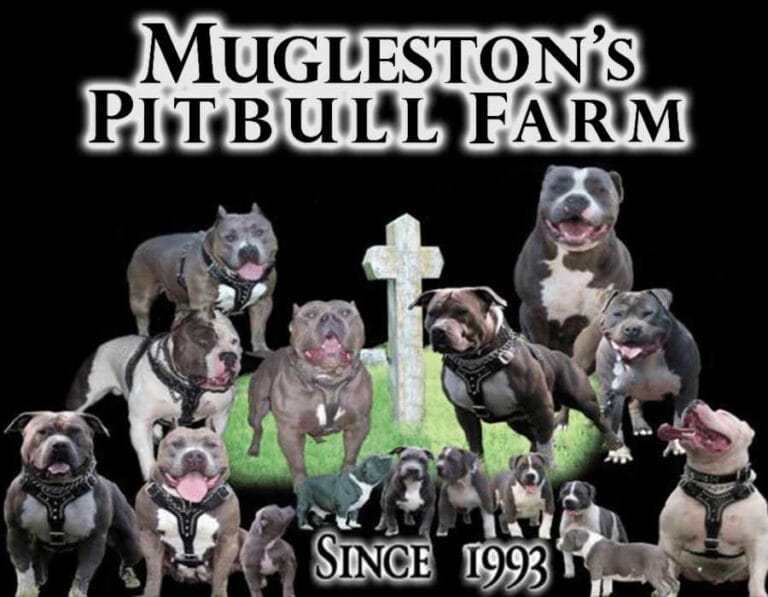
What to Know About Blue Nose Pitbull
Did you know Blue Nose Pitbulls are a special type of American Pitbull Terrier? They weigh between 30 to 60 pounds but have lots of energy. These dogs are known for their blue-gray noses and coats.
They are more than just good-looking. Blue Nose Pitbulls are loving and loyal, making them great family pets. Knowing these facts can help you decide if this rare and amazing variety is right for your family.

Facts Behind The Blue Nose Pitbull
- Blue Nose Pitbulls are a variant of the American Pitbull Terrier.
- They weigh between 30 to 60 lbs and stand around 17 to 21 inches tall.
- Known for their affectionate, loyal, and energetic traits.
- Require regular exercise and mental stimulation.
- Make excellent family pets, especially good with children.
What is So Special About Blue Nose Pitbulls?
Blue Nose Pitbulls are a special type of American Pitbull Terrier. They are known for their blue-gray coat and nose. This color comes from a rare gene that affects how they make melanin.
These dogs are very loving and loyal. They love to show affection to their family. They are great with kids and make wonderful pets.
Blue Nose Pitbulls are not just pretty; they are also smart and fun. They are easy to train and can be service dogs. They are strong and agile, making them great at many tasks.
They are medium-sized dogs, weighing 30-60 lbs and standing 17-21 inches tall. They have a muscular build, which makes them look strong and friendly. They need regular exercise to stay happy and healthy.
They can live for 10-14 years, depending on their diet and health care. While they share some traits with Red Nose Pitbulls, their blue-gray nose and coat are unique.
In summary, Blue Nose Pitbulls are special because of their rare coat and loving nature. They are great family pets and can adapt to different homes, as long as they get enough exercise and mental stimulation.
Blue Nose Pitbull History
The Blue Nose Pitbull comes from a long line of Pitbulls, including the Staffordshire bull terrier. They originated in 19th-century England. Breeders mixed Bulldogs with English terriers to create agile yet strong dogs, used in bull-baiting.
These dogs moved to America and changed from fighters to farm and hunting companions. They became known as American Pitbull Terriers. They were strong and loyal, making them great family pets.
The blue nose trait in Blue Nose Pitbulls comes from genetics, not a special breed. It happens when both parents have a certain gene. This makes these dogs rare. Ethical breeders focus on health and genetics, not just looks.
Blue Nose Pitbulls are rare but special. They are loving, loyal, and full of energy. They make great pets. But, some people think they are better just because of their looks. It’s important to choose a pet based on their personality and health, not just how they look.
Characteristics of Blue Nose Pitbull
Understanding the unique and striking features of the Blue Nose Pitbull can provide insight into why this breed is so adored. Let’s delve into the elements that set them apart.
How Do Blue Nose Pitbulls Look?
The Blue Nose Pitbull is easily recognizable due to its distinctive blue-gray nose and coat. They have a stocky build, often accompanied by a powerful and broad physique. Their short hair ranges from a striking bluish-gray to a captivating brindle coat, with some featuring prominent white markings.
The blue nose itself is a byproduct of a recessive gene, responsible for the breed’s unique pigmentation.
Blue Nose Pitbull Size
Size is another distinctive feature of the Blue Nose Pitbull. Males typically measure between 18 to 21 inches at the shoulder, while females usually range from 17 to 21 inches. Their weight can vary broadly between 30 to 60 lbs, depending on diet, exercise, and overall health.
Despite their size, they have a proportional and muscular stocky build that exudes strength and agility.
Coat Type
The coat of the Blue Nose Pitbull is another standout feature. Primarily, their short hair is known for being stiff, glossy, and easy to maintain. This makes it ideal for owners who prefer low-maintenance pets.
Their coat not only contributes to their sleek and powerful look but also requires minimal grooming.
Efficiency is key to owning a Blue Nose Pitbull. Their minimal grooming needs coupled with their stunning appearance and affectionate nature make them incredible companions suited for various lifestyles.
How Does a Blue Nose Pitbull Temperament?
Blue Nose Pitbulls are known for their affectionate and loyal nature. They bond strongly with families, making them great pets. They are especially gentle and protective around children, earning them the nickname “nanny dogs.”
These dogs are always up for fun. They love playing fetch or running around. But, they need lots of exercise to stay happy and healthy.
Blue Nose Pitbulls can get anxious when left alone. They love being with their owners and can get upset when separated. This can lead to bad behaviors like chewing or digging. It’s important to train them well and keep them company.
Common Health Problems
Skin Allergies
Blue Nose Pitbulls often have skin allergies. These can be caused by pollen, grass, ticks, flies, and certain foods. Signs include a lot of scratching, dry skin, and sunburn. Keeping their coat clean and using preventative care helps manage these issues.
Eye Problems
Cataracts are common in Blue Nose Pitbulls. They can be inherited or developed over time. These can be linked to diseases like diabetes. Regular vet visits are crucial for early detection and care.
Hip Dysplasia
Hip dysplasia affects Blue Nose Pitbulls’ mobility. It causes their hips to form improperly, leading to arthritis and pain. Symptoms include trouble climbing stairs and running. Early detection and care can help. Treatments like surgery and therapy can improve their life quality.
| Health Issue | Description | Preventative Measures |
|---|---|---|
| Skin Allergies | Allergic reactions to pollen, grass, ticks, flies, and food components. | Regular grooming, identifying and avoiding allergens. |
| Eye Problems | Cataracts due to inherited conditions or diseases like diabetes. | Routine vet check-ups, especially for eye health. |
| Hip Dysplasia | Improperly formed hips lead to arthritis and pain. | Early detection, therapeutic interventions. |
How to Care Blue Nose Pit Bulls?
Taking care of our Blue Nose Pit Bulls means focusing on a few important areas. These dogs are loyal and loving. They do well when we meet their needs for exercise, grooming, and diet.
An exercise regimen is key. Blue Nose Pit Bulls are full of energy and need at least 30 minutes of active play each day. This keeps them from getting too restless or developing bad habits. Running, playing fetch, and agility training are great for them.
Their grooming needs are simple. With a short coat, they don’t need much grooming. Brushing them regularly keeps their coat shiny. Bathing should be done when needed to avoid skin problems. It’s also important to watch for skin issues and use the right products.
Also, diet considerations are vital for their muscle health. They need a diet rich in protein to stay active and healthy. Always make sure they have fresh water. Their diet needs might change, so we need to adjust their meals accordingly.
For their health, regular vet visits and vaccinations are a must. This breed can get heart disease, hip dysplasia, and allergies. So, it’s crucial to keep an eye on their health to ensure they live a long life.
How to Train a Blue Nose Pitbull?
Training a Blue Nose Pitbull is rewarding because they are smart and love to please. Start obedience training early to build a well-behaved pet. They do well in training and dog sports. Positive reinforcement, like clicker training, works better than punishment.
It’s key to socialize Blue Nose Pitbull puppies early. Introduce them to different people, places, and animals. This helps them learn to get along and reduces aggression.
If your Pitbull is aggressive towards other dogs, get help from a pro or join classes. Advanced training and dog sports like agility keep them mentally sharp and strengthen your bond.
Start socializing your Blue Nose Pitbull with their mother, siblings, and breeder early. Begin socialization after two weeks at home. Introduce them to other dogs and animals between 10 and 16 weeks. Regular exercise and mental stimulation prevent boredom and aggression. A well-socialized Pitbull is friendly and tolerant in many situations.
How to Adopt Blue Nose Pitbull?
Adopting a Blue Nose Pitbull is a big decision. It needs careful thought and a real commitment to their care. You can look into responsible breeders or pet shelters.
It’s important to know what Blue Nose Pitbulls need. They have a cool blue-gray nose and coat. They are loving, loyal, and full of energy. They need lots of exercise and mental games to be happy.
Adopting from a responsible breeder means you get a healthy puppy. It’s key to find a breeder who cares about the dogs’ health. Make sure they check for health problems.
Choosing to adopt a Blue Nose Pitbull is a great chance to give one a loving home. Understanding the breed and what they need is important.
Make Up Your Mind to Get a Blue Nose Pitbull!
Deciding to bring a Blue Nose Pitbull into your life is a big commitment, and it’s important to choose the right dog that fits your needs and lifestyle. While Blue Nose Pitbulls are known for their striking appearance and loyal nature, finding a reputable breeder is key to ensuring you get a healthy, well-bred companion. When you’re ready to welcome a new pitbull into your family, it’s important to seek out breeders who prioritize quality and care in their breeding process.
At Mugleston Pitbull Farm, we specialize in breeding strong, loyal pitbulls with excellent temperaments. Our pitbulls are carefully bred to ensure health, socialization, and a strong connection with their future families. If you’re looking for a top-quality pitbull, explore our selection to find the perfect match for your home.
Question Hub
What are the typical traits of Blue Nose Pitbulls?
Blue Nose Pitbulls have a unique blue-gray fur and a loving personality. They are full of energy and have a sturdy build. They often have “white socks” on their paws. Despite their past in dogfighting, they are loving and great family pets.
What makes Blue Nose Pitbulls special?
Their blue-gray coat and nose make them stand out. They are loyal and loving, with a playful nature. They are smart and easy to train, making them excellent service dogs.
Where do Blue Nose Pitbulls come from?
They come from the Pitbull family. Their history goes back to 19th-century England. There, Bulldogs were mixed with English terriers. In the U.S., they became the American Pitbull Terriers, used for farm and hunting work.
How do Blue Nose Pitbulls look?
They have a broad and stocky body. Their fur is bluish-gray, sometimes with brindle patterns. They also have white markings, thanks to a special gene.
What are the common health problems in Blue Nose Pitbulls?
They can have skin allergies, eye issues like cataracts, and hip dysplasia. Regular vet visits and care are key to managing these problems.
How can I care for a Blue Nose Pitbull?
They need lots of exercise because of their energy. Their short coat means little grooming. They also need a diet rich in protein to keep their muscles strong. Regular health checks and skin care are important for their well-being.
What should I consider before getting a Blue Nose Pitbull?
Think about their long life as pets (12-15 years). Consider their health, exercise, and care needs. Knowing their needs and the love they offer will help you make a responsible decision.
